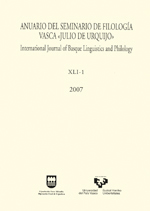Aditz jokatugabea eta "eta" enklitikoa
##plugins.themes.bootstrap3.article.main##
##plugins.themes.bootstrap3.article.sidebar##
Abstract
In this article, an analysis and description is carried out of the non-finite verbal Basque forms compatible with the clitic eta. The description shows prosodic and semantic features together with grammatical ones (morphological and syntactic). In Basque grammars, there are three forms: the so-called "present participle" (represented by -t(z)en), that is, -t(z)en eta (described in Part 1), the so-called "aditz-oina", that is, aditz-oina eta (described in Part 2) and, finally, the perfect participle, that is, -tu eta (according with the normal representation in our grammar). The analysis of this last one is by far the most interesting. We prove that -tu eta constitutes a single word (Part 3) in which eta has been entirely agglutinated and functions as a suffixe (amaituta, not **amaitueta, for example). Because of its homophony, this form covers two grammatical units: a gerund (Part 4) and a past participle (Part 5). The gerund is used in two different structures: the absolute constructions and the conjunct construction. As for the past participle, we find it in the so-called Periphrase Structures (with ergative verbs as well as absolutive ones) and in two different structures related to the opposition of diathesis: the passive voice and the antipassive one. Our research shows that both share a basic feature that has never been pointed out in previous studies.
How to Cite
##plugins.themes.bootstrap3.article.details##
This works is licensed under a Creative Commons Attribution-NonCommercial-NoDerivatives 4.0 International License.


